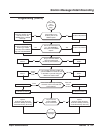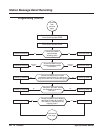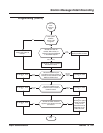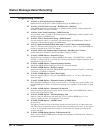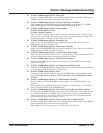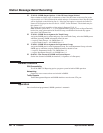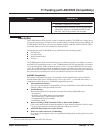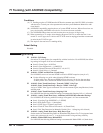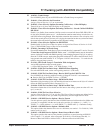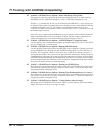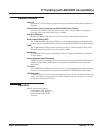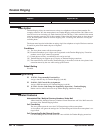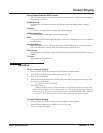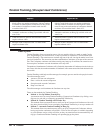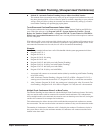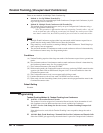
T1 Trunking (with ANI/DNIS Compatibility)
Aspire Software Manual Features ◆ 539
➻ 14-05-01 : Trunk Groups
For ANI/DNIS, place all your ANI/DNIS trunks in Trunk Groups as required.
➻ 20-06-01 : Class of Service for Extensions
Assign a Class of Service (1-15) to an extension.
➻ 20-09-02 : Class of Service Options (Incoming Call Service) - Caller ID Display
Turn off (0) or on (1) the Caller ID display at an extension
➻ 20-09-01 : Class of Service Options (Incoming Call Service) - Second Call for DID/DISA/
DIL/E&M
Enable (1) or disable (0) an extension’s ability to receive a second call from a DID, DISA, DIL, or
tie line caller. With this option set to ‘1’, the destination extension must be busy in order for a sec-
ond DNIS caller to ring through. If the destination extension does not have a line or loop key avail-
able for the second call and a previous call is ringing the extension but has not yet been answered,
the second caller will hear busy regardless of this program’s setting.
➻ 20-14-01 : Class of Service Options for DISA/E&M
Enable/disable tie line Class of Service options. Assign tie line Classes of Service in 34-02.
Up to 15 DISA/E&M Classes of Service can be defined.
➻ 22-02-01 : Incoming Call Trunk Setup
For each T1 trunk, set the Trunk Service Type to match the telco’s connected T1 service. For each
T1 trunk that should support ANI/DNIS service, enter 7. (ANI/DNIS trunks must be immediate
start or wink start T1 trunks with E&M signaling.) After changing Program 22-02-01, in order to
allow the T1 PCB to resync, unplug then plug back in either the T1 cable or the PCB itself. For T1
loop/ground start trunks defined as “0”, Program 14-02-02 must be set to ‘1’ in order for the
trunks to ring and lamp correctly.
➻ 22-13-01 : DID Trunk Group to Translation Table Assignment
Assign DID translation tables to trunk groups.
➪ Aspire DID Translation Tables: 1-20, Trunk Groups: 1-100
➻ 34-01-01 : E&M Tie Line Basic Setup - DID/E&M Start Signaling
For each ANI/DNIS trunk, set the start signaling mode to 1 (wink start).
➻ 34-01-02 : E&M Tie Line Basic Setup - Receive Dial Type for E&M Tie Line
For ANI/DNIS, the following additional setting in Program 34-01-02 is recommended:
● Receive Dial Type for E&M Tie Line = 1 (DTMF)
➻ 34-01-03 : E&M Tie Line Basic Setup - E&M Dial-In Mode
Determine if the incoming tie line call should be directed as an intercom call (0) or if it should
follow the DID Translation Table in Program 22-11 (1).
➻ 34-10-04 : E&M Tie Line Basic Setup - E&M Line Dial Tone
Determine whether the tie line should send dial tone to the calling system once the call is set
up (1) or not (0).
➻ 34-02-01 : E&M Tie Line Class of Service
Assign a Class of Service (1-15) to a tie line. The Class of Service options are defined in Pro-
gram 20-14. For each tie line, you make a separate entry for each Night Service mode.
➻ 34-09-01 : ANI/DNIS Service Options - Receive Format
Use this option to specify the format of the ANI/DNIS data received from the telco. Make sure
your entry is compatible with the service the telco provides (0 = Address, 1 = *ANI*, 2 =
*DNIS*, 3 = *ANI*Address*, 4 = *ANI*DNIS*, 5 = *DNIS*ANI* [* = Delimiter Code]).
➻ 34-09-02 : ANI/DNIS Service Options - Delimiter Dial
This option defines the character telco uses as a delimiter (see entries 1-5 in 34-09-01). Valid
entries are 0-9, #, and *.
➻ 34-09-03 : ANI/DNIS Service Options - Route Setup of Receive Dial
This option specifies the source of the data the system uses to route incoming ANI/DNIS
calls. If option ‘2’ is selected, refer to Program 34-09-04 (0 = Fixed Route (Item 08), 1 =
Routes on Received DNIS or Address Data, 2 = Routes on Received ANI Data).



